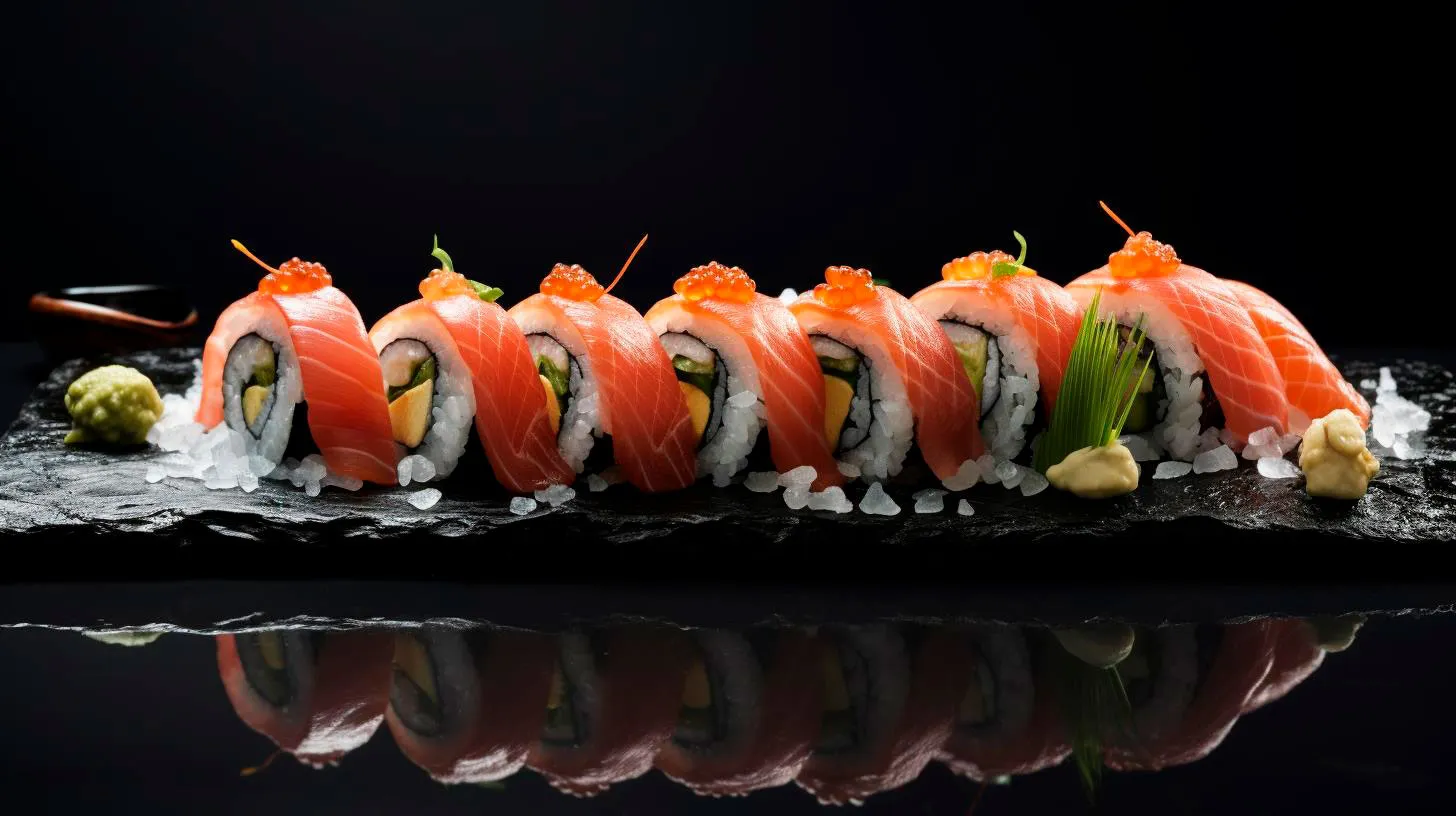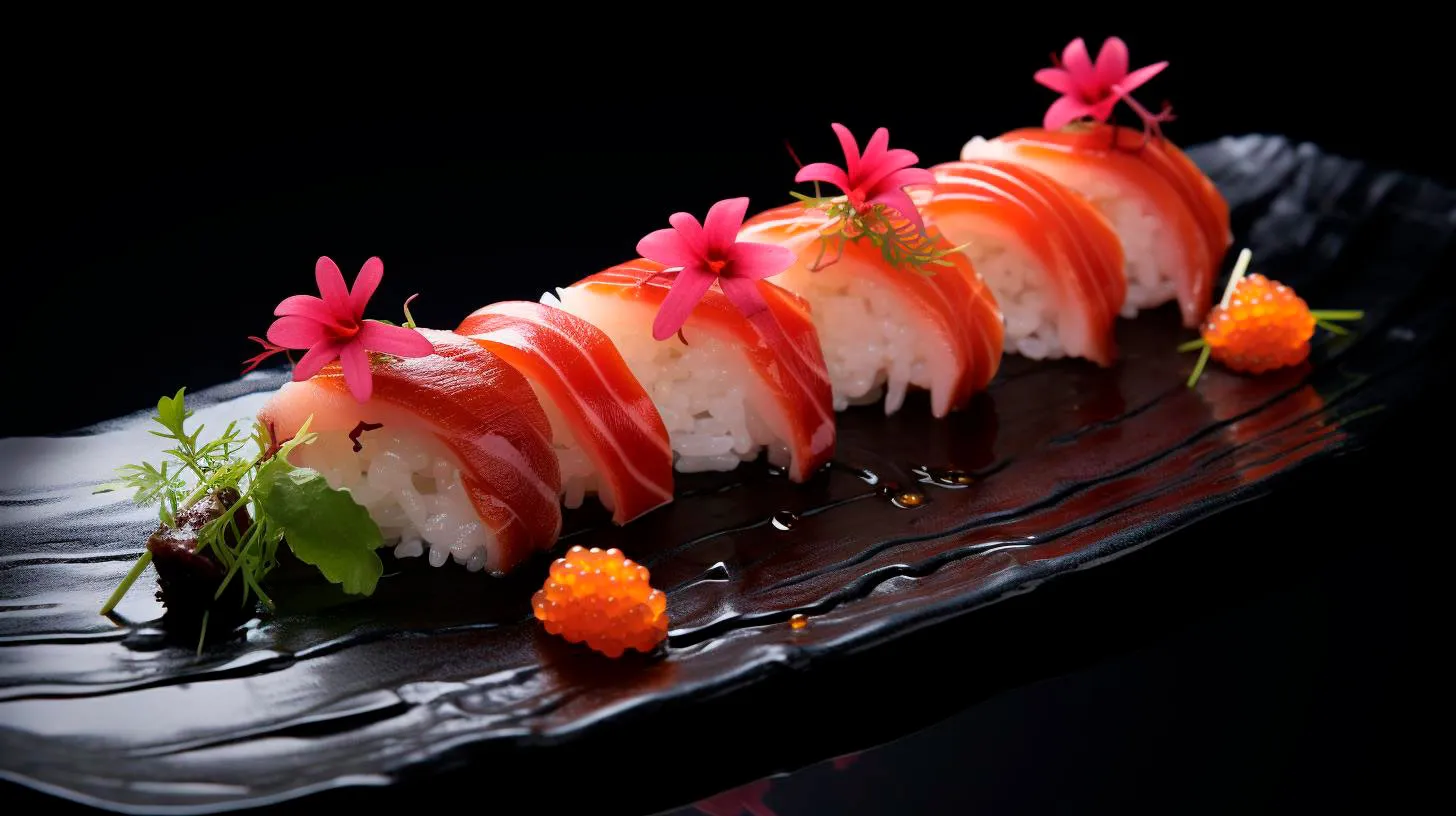The Rise of Gluten-Free Sushi: Exploring a Paradigm Shift
This has led to an emergence of gluten-free alternatives for various food items, including the beloved Japanese delicacy – sushi. In this article, we will delve into the rise of gluten-free sushi and explore how it has brought about a paradigm shift in the culinary world.
Understanding Gluten-Free Diets
Before we discuss the specific aspects of gluten-free sushi, it is essential to understand the core principles of a gluten-free diet. Gluten is primarily found in wheat, barley, rye, and products derived from these grains. Individuals following a gluten-free diet must avoid all foods containing gluten, as even small amounts can lead to severe health complications.
Gluten-free diets are not limited to just those with celiac disease or gluten intolerance. Many individuals adopt this dietary approach for various reasons, including weight management, promoting a healthy gut, and reducing inflammation. As a result, the demand for gluten-free food options has skyrocketed in recent years.
The Evolution of Gluten-Free Sushi
Sushi, a beloved Japanese cuisine, has long been associated with rice, fresh fish, and nori (seaweed). However, the soy sauce and various sauces used in sushi preparation often contain gluten. This posed a significant obstacle for those following a gluten-free diet who wished to indulge in this delectable dish.
In response to the growing demand for gluten-free options, innovative techniques and ingredients have been introduced to create an alternative version of sushi. Some of the key changes include:
- Gluten-Free Soy Sauce: Traditional soy sauce contains wheat, making it unsuitable for those avoiding gluten. However, gluten-free soy sauce has been developed using ingredients like Tamari, which replaces wheat with alternative grains like rice or soybeans.
- Alternative Wrappers: Seaweed wrappers, known as nori, often used in sushi contain gluten binders. To cater to gluten-free aficionados, sushi can now be wrapped in cucumber, soy paper, or rice paper.
- Gluten-Free Fillings: Another crucial aspect of gluten-free sushi is the fillings. Traditional ingredients like imitation crab, tempura, and certain fish sauces may contain gluten. Gluten-free options include fresh fish, vegetables, fruits, and various creative combinations that eliminate the need for gluten-containing ingredients.
These adaptations and innovations have opened up a whole new realm of possibilities for sushi lovers who follow a gluten-free lifestyle while still enjoying the flavors and textures they adore.
The Advantages of Gluten-Free Sushi
The rise of gluten-free sushi brings forth several advantages for different groups of people:
1. Health-Conscious Individuals:
- Gluten-free sushi provides an option for individuals with celiac disease or gluten intolerance to enjoy a popular and culturally significant dish without compromising their health.
- It accommodates those who follow a gluten-free lifestyle for other health reasons, such as gut health, weight management, or reducing inflammation.
2. Culinary Creativity:
- The evolution of gluten-free sushi has spurred new and exciting flavor combinations, utilizing alternative fillings, wrappers, and seasonings.
- Chefs and home cooks alike can experiment with these innovative ingredients, elevating the sushi experience for all individuals, regardless of dietary restrictions.
3. Business Opportunities:
- Restaurants and sushi establishments that cater to gluten-free individuals can tap into a growing market segment, attracting a broader customer base.
- By incorporating gluten-free options, these establishments demonstrate inclusivity, enhancing their reputation and attracting customers who appreciate accommodating dietary needs.
Key Takeaways
The rise of gluten-free sushi is not only a response to the increasing demand for diet-specific options but also a testament to the culinary industry’s adaptability and innovation. Some key takeaways from this paradigm shift include:
- Gluten-free diets are gaining popularity, leading to the rise of gluten-free alternatives for various food items.
- Gluten-free sushi offers a safe and delicious option for those with celiac disease or gluten intolerance.
- Innovative techniques and ingredients, such as gluten-free soy sauce, alternative wrappers, and fillings, have revolutionized the sushi experience.
- This shift provides benefits for health-conscious individuals, encourages culinary creativity, and presents business opportunities for restaurants.
As the demand for gluten-free options continues to grow, the sushi industry has successfully adapted and thrived, providing a wider range of choices for sushi enthusiasts while adhering to dietary restrictions.
In Conclusion
The rise of gluten-free sushi represents a paradigm shift in the culinary world. It showcases the industry’s ability to adapt to changing consumer demands and cater to specific dietary restrictions without compromising on taste and quality. Whether you are following a gluten-free lifestyle or simply seeking new and exciting flavors, gluten-free sushi offers an inclusive and delightful dining experience. So, next time you visit a sushi establishment, don’t hesitate to explore the diversity of gluten-free options available. Your taste buds will thank you!
Adapting Tradition: Embracing Gluten-Free Options in Sushi Cuisine
However, as dietary restrictions become more prevalent, it is crucial for sushi chefs and restaurants to adapt their offerings to cater to those with specific dietary needs. One such dietary restriction that has gained significant attention in recent years is gluten sensitivity or celiac disease.
The Rise of Gluten Sensitivity
Gluten sensitivity affects a significant portion of the population, with estimates placing the prevalence between 5% and 10% worldwide. This condition, which results in adverse reactions to gluten, a protein found in wheat, barley, and rye, requires individuals to adopt a strict gluten-free diet to avoid discomfort and potential health complications.
The Challenges of Gluten-Free Sushi
Traditionally, sushi incorporates ingredients like soy sauce, tempura, and certain types of fish that may contain gluten. Adapting sushi to be gluten-free poses a unique challenge, as altering these fundamental ingredients while still maintaining the authentic taste and texture is no easy feat.
However, sushi chefs and restaurants are rising to the occasion, utilizing innovative techniques and ingredients to create gluten-free options that are as delicious and enjoyable as their traditional counterparts. Let’s explore some key adaptations and substitutes that are transforming the sushi culinary landscape:
- Gluten-Free Soy Sauce: A crucial element in the sushi experience is soy sauce. Traditionally brewed soy sauce contains gluten, posing a problem for gluten-sensitive individuals. However, gluten-free soy sauce alternatives made from tamari, a soy sauce-like condiment, are now widely available. These gluten-free soy sauces closely mirror the rich umami taste and flavor of traditional soy sauce, providing an essential option for those who follow a gluten-free diet.
- Creative Rice Substitutes: Sushi rice, which is a staple ingredient in traditional sushi rolls, usually contains vinegar, sugar, and sometimes soy sauce. By replacing traditional sushi rice with gluten-free options like quinoa, cauliflower rice, or even sticky wild rice, sushi chefs can create gluten-free sushi rolls without sacrificing the taste and texture that sushi aficionados crave.
- Tempura Alternatives: Tempura, a popular ingredient in sushi, consists of battered and deep-fried vegetables or seafood. The batter traditionally contains wheat flour, rendering it unsuitable for those on a gluten-free diet. Chefs have now begun experimenting with gluten-free flours, such as rice flour or cornstarch, to create light and crispy tempura coatings that are entirely gluten-free.
- Safe Ingredient Selection: It’s crucial for sushi chefs to maintain awareness and educate themselves about the ingredients they use to minimize the risk of cross-contamination or hidden sources of gluten. Ensuring that all ingredients, including the vinegar, nori (seaweed), and toppings, are gluten-free is essential to create safe and delicious sushi for individuals with celiac disease or gluten sensitivity.
The Benefits of Embracing Gluten-Free Options
By incorporating gluten-free options into their menus, sushi restaurants can unlock a range of benefits:
- Expand Customer Base: By catering to gluten-sensitive individuals, sushi restaurants can attract a broader customer base, tapping into the sizable population who actively seek gluten-free dining options.
- Enhance Dining Experience: Offering gluten-free sushi allows those with gluten sensitivity to savor traditional Japanese cuisine without compromising on taste or texture, providing a satisfying and enjoyable dining experience.
- Brand Differentiation: In an increasingly competitive market, sushi restaurants that adapt to dietary restrictions can set themselves apart from the competition. By highlighting their gluten-free options, they showcase their commitment to customer satisfaction and inclusivity.
- Health Considerations: For individuals with celiac disease or gluten sensitivity, consuming gluten can lead to long-term health consequences. Serving gluten-free sushi demonstrates a conscious effort to promote well-being and accommodate various dietary needs.
As sushi continues to captivate the world with its exquisite flavors and artistry, adapting this culinary tradition to embrace gluten-free options is both a necessity and an opportunity. By exploring alternatives and employing creative techniques, sushi chefs and restaurants can ensure that everyone gets to savor this beloved cuisine, regardless of their dietary restrictions. So, let’s celebrate the adaptability of sushi and embrace its gluten-free evolution!
Revolutionizing Sushi: Unlocking the Potential of Gluten-Free Variations
Fortunately, innovative chefs and food establishments are revolutionizing sushi by unlocking the potential of gluten-free variations. In this article, we will explore the growing popularity of gluten-free sushi and the benefits it offers for both consumers and the food industry.
The Rise of Gluten-Free Awareness
Gluten intolerance and celiac disease affect millions of people worldwide. According to recent statistics, approximately 1 in 100 people have celiac disease, while 6-7% of the global population suffers from some form of gluten intolerance. These conditions require individuals to avoid consuming gluten, a protein found in wheat, barley, and rye. As a result, a demand for gluten-free alternatives in various cuisines, including sushi, has emerged.
Understanding Gluten-Free Sushi
Traditional sushi is typically made with vinegar-seasoned rice and various fillings, such as raw or cooked fish, vegetables, and seaweed. However, the use of soy sauce, which contains gluten, poses a challenge for those on a gluten-free diet. Nonetheless, chefs have found creative ways to substitute or eliminate gluten-containing ingredients, making sushi accessible to a wider audience.
Here are some key takeaways when it comes to gluten-free sushi:
- Gluten-free ingredients: Chefs use gluten-free soy sauce alternatives, such as tamari, which is made without wheat. They also opt for gluten-free vinegar and carefully select fillings, ensuring they are free from gluten sources.
- Alternative sauces: Chefs create unique gluten-free sauces using ingredients like gluten-free miso paste, wasabi, and ginger, adding a burst of flavor to gluten-free sushi rolls.
- Specialized techniques: Sushi chefs often modify their cooking techniques to accommodate gluten-free diets. For example, they may dedicate separate utensils and preparation areas to avoid cross-contamination.
Benefits of Gluten-Free Sushi
The emergence of gluten-free sushi offers several advantages for both consumers and the food industry. Let’s take a closer look at some key benefits:
1. Catering to dietary restrictions
Gluten-free sushi allows individuals with gluten intolerance or celiac disease to enjoy this beloved Japanese cuisine without compromising their health. It promotes inclusivity and expands dining options for those with dietary restrictions.
2. Attracting a wider customer base
By offering gluten-free sushi, restaurants and sushi bars can attract a larger customer base. This not only includes people following a gluten-free diet but also those who simply prefer gluten-free options or are looking to try something new and exciting.
3. Enhancing menu diversity
Including gluten-free sushi on the menu adds diversity and variety to the restaurant’s offerings. It provides more choices for customers and showcases the chef’s ability to adapt and innovate within the culinary world.
Embracing the Gluten-Free Sushi Trend
As the demand for gluten-free options continues to rise, restaurants, food establishments, and sushi bars are encouraged to embrace the gluten-free sushi trend. By doing so, they can cater to a broader customer base and stay ahead in a competitive market.
Here are some actionable steps to embrace the gluten-free sushi trend:
- Research gluten-free ingredients: Chefs should explore gluten-free alternatives to traditional sushi ingredients and experiment with new flavors and textures.
- Train staff: Educating kitchen staff about gluten-free diets and safe handling practices is crucial to avoid cross-contamination and ensure customers’ safety and satisfaction.
- Market the gluten-free options: Promote the availability of gluten-free sushi through online and offline marketing channels. Highlight the unique flavors and the efforts made to accommodate gluten-free diets.
- Solicit customer feedback: Encourage customers to provide feedback on gluten-free sushi options, allowing you to continuously improve and refine your offerings.
In conclusion, revolutionizing sushi by unlocking the potential of gluten-free variations has sparked a wave of innovation and inclusivity in the industry. Gluten-free sushi not only caters to dietary restrictions but also enhances menu diversity and attracts a wider customer base. By embracing this trend, restaurants can stay ahead of the competition and delight customers with unique, delicious sushi options that cater to all tastes and needs.
From Traditional to Modern: The Gluten-Free Sushi Movement
In this article, we will dive into the world of gluten-free sushi, its innovative features, key benefits, and why it’s a game-changer for sushi lovers with dietary restrictions.
Understanding Gluten-Free Sushi
Gluten-free sushi is a revolutionary concept that caters to individuals who have an intolerance to gluten, as well as those who adopt a gluten-free lifestyle. Traditionally, sushi is made using vinegar-seasoned rice wrapped in seaweed with various fillings, such as raw or cooked fish, vegetables, and condiments. However, the ingredients used in gluten-free sushi are carefully selected to exclude any gluten-containing products.
The Features and Advantages of Gluten-Free Sushi
- Gluten-free ingredients: The primary advantage of gluten-free sushi is the absence of gluten-containing ingredients, making it safe for consumption for those with gluten sensitivities and celiac disease.
- Increased menu options: The gluten-free sushi movement has prompted sushi chefs to explore alternative ingredients and techniques, resulting in a broader range of flavors and options for customers.
- Health benefits: Gluten-free sushi often incorporates nutrient-rich ingredients like fresh fish, organic vegetables, and seaweed, providing a balanced and healthy meal.
- Inclusive dining experience: Offering gluten-free options in sushi restaurants allows people with and without dietary restrictions to dine together, fostering a sense of inclusivity and eliminating the need for separate meals.
The Rise of the Gluten-Free Sushi Movement
The demand for gluten-free options has skyrocketed in recent years. According to a study by Research and Markets, the global gluten-free food market is projected to reach $8.3 billion by 2023. Sushi restaurants have recognized this shift in consumer preferences, prompting them to adapt their menus accordingly. The gluten-free sushi movement has gained significant momentum, with a growing number of innovative sushi chefs and restaurants embracing this trend.
The Key Takeaways from the Gluten-Free Sushi Movement
- Menu diversity: Gluten-free sushi offers an extensive choice of ingredients, fillings, and flavor combinations, catering to a wider range of dietary needs and preferences.
- Enhanced dining experience: The availability of gluten-free options ensures that everyone can enjoy the sushi experience without the worry of dietary restrictions.
- Increased awareness: The gluten-free sushi movement has raised awareness about gluten sensitivity and celiac disease, promoting conversations and understanding about these conditions.
- Encourages culinary innovation: The need to create gluten-free alternatives has pushed sushi chefs to think outside the box, resulting in inventive and delicious sushi creations.
The Future of Gluten-Free Sushi
As the demand for gluten-free options continues to grow, the future of gluten-free sushi looks promising. Advancements in culinary techniques and ingredient sourcing have allowed chefs to create gluten-free sushi that rivals its traditional counterpart in taste and presentation. With more people adopting gluten-free diets and seeking inclusive dining experiences, sushi restaurants worldwide are likely to expand and refine their gluten-free offerings to meet the rising demand.
In Conclusion
The gluten-free sushi movement has breathed new life into the world of sushi, making this beloved cuisine accessible to those with gluten sensitivities or celiac disease. With its innovative features, health benefits, and broadened menu options, gluten-free sushi has become a game-changer. As the movement continues to gain momentum, sushi restaurants worldwide are embracing this trend, ensuring that everyone can indulge in the beauty of sushi without compromising their dietary needs.



